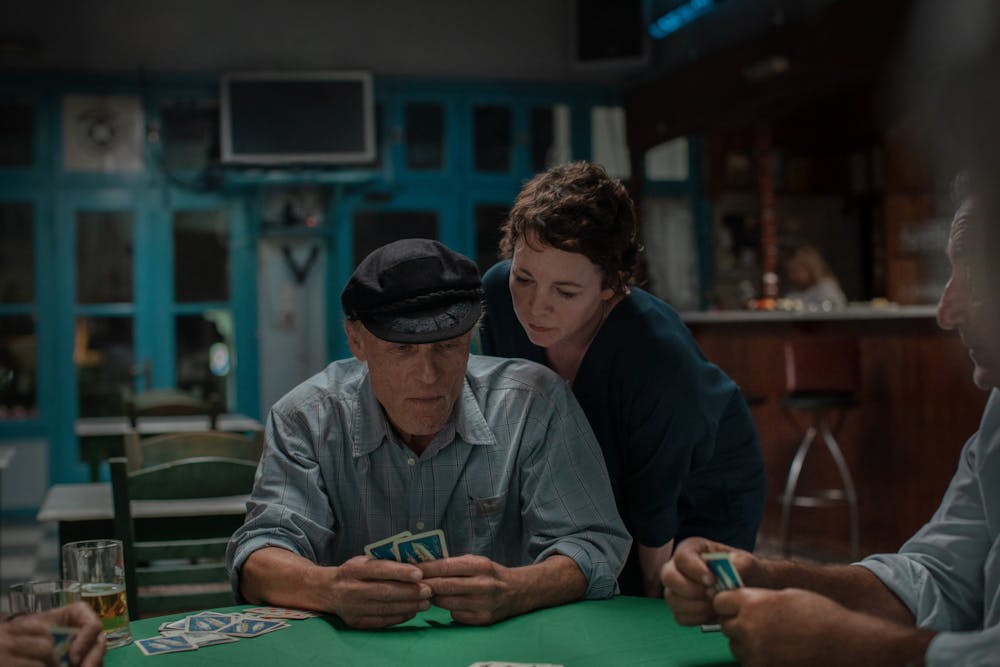“The Lost Daughter” is one of those films that prides itself on making viewers uncomfortable. In its sparse dialogue, long close-up camera shots and uneasy glances between characters, it has found a way to glue audience members to their seats. Anticipation buzzes around every scene as a hazy conviction that something is not quite right in the main character Leda’s life emerges — a conviction which only gradually becomes clear. It is this uncertainty that makes the film so intriguing, along with the soft, creeping notion that something very bad is always about to happen. And so when nothing transpires, not only does the movie lose all intrigue, but it also makes the viewers wish they hadn’t stayed sitting for so long.
“The Lost Daughter,” an adaption of Elena Ferrante’s novel directed by Maggie Gyllenhaal, tells the story of Leda’s (Olivia Colman) vacation to Greece. After taking time off from her job as a college professor and traveling to Europe alone, she befriends Nina (Dakota Johnson), a young mother and the black sheep of her own family. Nina is vain and slightly obnoxious, irritable, distracted and depressed.
In Nina, Leda sees a version of her younger self when she first entered motherhood. She sees her past negligence in the way Nina looks after her three-year-old daughter Elena and becomes obsessed with watching the two interact. Memories of her own daughters come streaming back and are interspersed between scenes of the present: Leda yelling at them, Leda growing frustrated with them and Leda peeling oranges for them “like a snake.” It is within these scenes that viewers begin to truly dislike the young Leda (Jessie Buckley); she is made out to be a selfish, inattentive and overall terrible mother.
It is also within these scenes that the looming notion of secrecy in Leda’s life is given some ground. As her past is uncovered, viewers begin to understand why Leda acts the way she does — why her theft of Elena’s doll, for example, is a warped but perfectly characteristic action. And why the meticulous attention she gives to it — bathing it and dressing it while hiding it from Nina’s family — is nonetheless meaningful.
Leda eventually reveals to Nina that she abandoned her family for a few years during her daughters’ childhoods. She admits, with bitter honesty, that the break felt “amazing.” While Leda confides in Nina under the guise of empathizing over the struggles of motherhood, the confession is for herself more than anyone else. As the final scenes of the film close — depicting Leda, first by herself and then with her daughters, peeling an orange on the beach — it becomes apparent that she has finally come to terms with her biggest mistake in life. Or rather, that she at least has started to do so.
The film is shot beautifully, with cinematographer Hélène Louvart using an at times unfocused, bluish filter that makes “The Lost Daughter” feel as if it is watched through a window rather than on a high definition screen. Olivia Colman’s performance was fantastic — incredibly difficult to pity, yet impossible to simply despise. Dakota Johnson delivered a similarly complex performance, and Jessie Buckley’s confidence on screen is not to be disregarded.
The soundtrack is modest — mostly lyricless but tastefully chosen. It effortlessly fills the space between the cautiously placed dialogue, serving to bolster the actors’ work rather than take away from it.
Although intriguing, “The Lost Daughter” fails to deliver on the promise it makes with viewers at the beginning of the film. The secrecy and anticipation, as well as the knowledge that Nina’s family are “bad people,” lead one to believe that some terrible harm is inevitably going to come to Leda. Most of the movie is spent waiting in suspense of this moment — the buildup to which is what’s primarily responsible for capturing viewers’ attention. And so it comes as a bit of a shock when no serious emotional consequences materialize — even after Nina stabs Leda upon discovering that she has stolen the doll.
There is the film’s main problem: it lets this deal with its audience go unfulfilled. Although Leda facing retribution for stealing Elena’s doll is not the point of the movie, the lack of any real consequence leaves the “The Lost Daughter” feeling plotless. Its obsession with the tragic nuances of mother-daughter relationships are likely much better suited for Ferrante’s novel as they were initially portrayed.
“The Lost Daughter,” if nothing else, is a prime example of what the cinematic world has increasingly become. It focuses more on camera angles than dialogue and gains meaning through glances rather than contentious interaction. The film’s aestheticism has clearly taken precedence over its storytelling, and the result is most definitely lacking.

Rya is an Arts & Culture editor from Albany, NY. She is a senior studying English and Literary Arts, and her favorite TV show is Breaking Bad.





